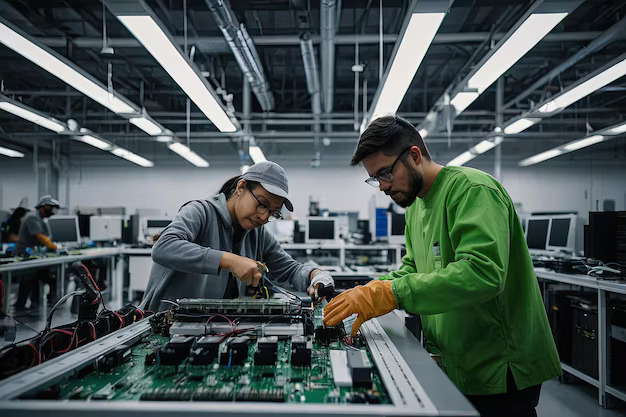Starting a Semiconductor Manufacturing Plant in India is an ambitious and large-scale endeavor that requires meticulous planning, significant financial investment, and a deep understanding of the semiconductor industry. Here’s a detailed breakdown for those looking to start a semiconductor manufacturing plant in the region.
Market Research and Business Plan
Identify the dynamics of market in semiconductor sector. Determine what type of semiconductors your factory will produce- microprocessors, memory chips or Integrated Circuits (ICs). Do a SWOT evaluation to discover the stamina’s, weaknesses, chances and hazards in this market. Establish an extensive business plan, outlining your marketing and operational strategies as well economic ones.
Location
The place of your plant will significantly influence your operation. Think about variables such as accessibility to proficient labor, closeness to distributors and also consumers, infrastructure, cost of land, as well as accessibility of energies (like water, electrical power, and gas).
Regulatory Approvals
Get needed approvals and also licenses from the federal government. In India, this consists of approvals from the Ministry of Electronics and Infotech (MeitY), Ministry of Atmosphere, Woodland and also Climate Change for environmental clearances, as well as city government authorities for land and also building authorizations.
Investment and Funding
Setting up a semiconductor manufacturing plant requires large capital investment, that can reach even billions of dollars. This includes expenses for land procurement, construction and equipment cost as well as technology purchase price; operational costs among others. Identify potential fundraising options – bank loans, venture capital/ private equity, government grants etc.
Technology and Equipment
Semiconductor manufacturing entails the use of extremely specialized machinery as well as equipment, such us lithography systems, engraving tools, ion implantation devices etc. It helps when you can partner with a modern technology company, or purchase from someone who has the connections. Plus, you will have to invest in state-of-the-art production technology, but also for screening and quality control.
Partnerships and Alliances
Developing partnerships, alliances with technological partners, suppliers and potential customers. It will vary from relationships with foreign semiconductor companies, to arrangements for your production equipment as well as contracts regarding where and which products of other manufacturers that use the chips you are supplying.
Staffing and Training
Invest in training to make sure they really understand the complexities of semiconductor manufacturing.
Construction and Setup
Build your plant as per design of semiconductor fabrication plant. It also includes clean rooms, production lines and labs for testing and analysis.
Quality Assurance and Certifications
Develop a solid quality management system to guarantee excellence for your semiconductors. Obtain necessary certifications like ISO 9001 for quality management systems.
Production and Operations
Start production in a phased manner, slowly ramping up your output while ensuring the quality of your products.
Marketing and Sales
Just like any kind of company, effective advertising as well as sales methods are vital. This entails understanding your consumers’ demands, placing your items in the appropriate means as well as creating a solid partnership with customers. This can be done through digital marketing, taking part in market expos or even by having a dedicated sales team.
Getting a semiconductor manufacturing plant going in India is no small task and requires large scale of investment, strategic planning and requisite talent workforce. However, with the Indian Central government focused on ‘Make in India’ and also semiconductor demand soaring globally, Bengaluru has lots of potential here. You can establish the ground an effective venture in cloud-based semiconductor manufacturing, by adapting your methodologies to these opportunities. Now, we shall move on by delving into the far complex aspects of how to set up a semiconductor fabrication plant in India.
Visit: Best Industry for Doing Business
Read Similar Articles: STARTUP BUSINESS
In-depth Planning for Market Positioning
Knowing where you stand in the marketplace is crucial for your plant. You could target the low-end market, which primarily focuses on producing common semiconductors in high volumes, or the premium market, which is driven by the most current modern technology as well as advancement. It’s required to understand your clients’ demands, competitor offerings, as well as existing market fads to identify your market placing accurately.
Further analysis on investment requirements
Aside from the apparent costs for land, building and construction, as well as tools, there are various other costs to consider. These can consist of recurring expenditures like resources, labor, energies, research and development, and upkeep. Do not fail to remember the expense of obtaining the essential licenses as well as licensing charges for the technology used in your plant. Functional expenses, including the cost of electrical energy, water, as well as specialized gases, are specifically substantial. A big semiconductor plant can take in substantial quantities of water as well as electrical power daily, so be sure to factor in these expenditures.
Importance of Cleanroom Design and Maintenance
Cleanrooms in a semiconductor plant are environments with a low degree of environmental pollutants like dust, air-borne germs, aerosol fragments, and also chemical vapors. The layout as well as maintenance of these cleanrooms are essential since even a minute fragment can trigger considerable flaws in the semiconductor production procedure. Air shower access, High-Efficiency Particulate Air (HEPA) filters, and also consistent surveillance of the environment are among the required cleanroom demands.
Adherence to Environmental Regulations
Semiconductor manufacturing plants are understood to produce significant waste as well as can cause considerable ecological effect. For that reason, these plants need to comply with strict ecological regulations connected to air emissions, water discharge, as well as contaminated materials disposal. Besides, semiconductor manufacturing eats vast amounts of water, and effective water monitoring and recycling systems must remain in place.
R&D and Innovation
Rapid technical innovations are a consistent in the semiconductor market, as well as without a solid focus on research and development, any kind of supplier could swiftly become obsolete. Consequently, a considerable part of the investment ought to be directed towards R&D. Tying up with universities, establishing dedicated R&D departments, or entering into calculated partnerships with global modern technology leaders could be advantageous.
Supply Chain Management
Rapid technical innovations are a constant in the semiconductor market, and without a solid focus on research and development (R&D), any supplier could swiftly become obsolete. Accordingly, a major portion of the investment required to start a semiconductor manufacturing plant should be allocated to R&D. Establishing dedicated R&D departments, forming strategic partnerships with global technology leaders, or aligning with universities can significantly enhance innovation capabilities and long-term competitiveness.
Intellectual Property Protection
Semiconductor fabrication is highly technical in its nature — and with that comes the need to safeguard your intellectual property (IP). Whether it is your production process, the design of your chips or innovation in your plant.
Feasibility Study Reports: Detailed Project Reports
Risk Management
To start a semiconductor manufacturing plant is to venture into a highly complex and capital-intensive industry. It entails various risks—from fluctuating market demands and technological challenges in production to evolving regulatory landscapes and intense cost pressures.
A detailed threat management strategy is essential. This involves identifying potential threats, assessing their impact, developing mitigation strategies, and continuously monitoring them. Proactive risk management not only safeguards operations but also ensures long-term sustainability and competitiveness in the semiconductor sector.
Continuous Improvement
In the highly competitive semiconductor sector, the quest for renovation should be ruthless. This could be in the form of enhancing making effectiveness, lowering waste, increasing item high quality, or enhancing employee safety. Lean as well as Six Sigma techniques can be utilized to promote a culture of constant renovation in your plant.
Conclusion
Establishing an Indian semiconductor manufacturing plant is not only a complex task but also costly. However, with the perfect preparation along with funding and partnerships together using a group, this is still an established target. Today, more than ever before semiconductors carry a lot weight in the technology driven world, we live making it one of those industries with immense potential.
As you start your semiconductor manufacturing plant, remember that success in this space goes far beyond mastering technology. It’s about deeply understanding the market, forging strong partnerships, remaining agile, and consistently driving innovation and improvement.
Building a resilient organization means navigating today’s complex challenges while positioning yourself for tomorrow’s opportunities. Most importantly, it’s about developing a product that, though invisible to most end-users, forms the backbone of the modern digital world.






